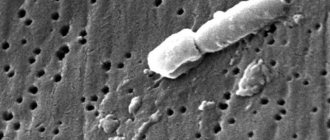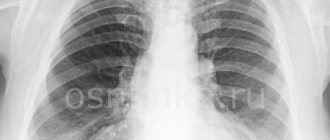Pneumonia
Cold
Fungus
11646 January 13
IMPORTANT!
The information in this section cannot be used for self-diagnosis and self-treatment.
In case of pain or other exacerbation of the disease, diagnostic tests should be prescribed only by the attending physician. To make a diagnosis and properly prescribe treatment, you should contact your doctor. Pneumonia: causes, symptoms, diagnosis and treatment methods.
Pneumonia is an acute infectious disease predominantly of bacterial origin, which is characterized by damage to the lung tissue and leads to impaired respiratory function. The disease has typical clinical manifestations.
Pneumonia has been known for a long time, but its successful treatment became possible after the discovery of microorganisms (bacteria, viruses, fungi), the fact of their participation in the development of inflammation in the lungs and the development of specific antimicrobial drugs - antibiotics. Before this, pneumonia was a common cause of death in people of all ages.
Causes
The primary cause of pneumonia is an infectious pathogen.
Most often these are bacteria, less often – viruses and parasitic fungi. Their penetration into the lungs is accompanied by activation of the immune system and the development of an inflammatory response, the main goal of which is to destroy the pathogen.
However, during the body’s fight against infection, damage to its own tissues occurs, including pulmonary tissue, which underlies the occurrence of pneumonia. The release of specific biologically active substances, as well as the entry into the blood of waste products of microorganisms, determines the development of a systemic reaction of the body to an infectious pathogen. Therefore, in case of pneumonia, especially severe, disruption of the functioning of other organs and systems plays a significant role.
Classification
There are several criteria based on which pneumonia is classified.
Thus, depending on the nature of the pathogen, bacterial, fungal, parasitic, viral pneumonia and pneumonia of mixed etiology are distinguished.
The inflammatory process can be unilateral, involving only one lung, or bilateral.
Depending on the volume of the lesion in each lung, pneumonia is classified into focal, segmental, lobar, etc.
Pneumonia is not a mild disease; the prognosis is always serious. However, there is a group of severe pneumonias that require intensive treatment and medical supervision with mandatory hospitalization.
In the medical environment, pneumonia is divided into community-acquired and hospital-acquired.
This gradation is based on the moment of infection: outside the hospital or in the hospital. This indicator is integral, reflecting the possible spectrum of infectious agents (more aggressive pathogens, perhaps even resistant to a number of antibacterial agents, are more common in hospitals), their sensitivity and resistance to the main groups of antimicrobial drugs, the person’s previous health status and the general prognosis of the disease.
Symptoms of pneumonia
Manifestations of pneumonia can be divided into general and local. The first will include symptoms of intoxication. They indicate the presence of an infectious process in the body in general, and not specifically in the lung tissue.
Fever, general weakness, fatigue, loss of appetite, headache, drowsiness - these symptoms are characteristic of a variety of diseases, and not only those of infectious origin.
Therefore, in the diagnosis of pneumonia, the most important characteristic signs from the respiratory system are: cough, shortness of breath, and the appearance of pain in the chest area.
During the examination, the doctor determines a change in the density of the lung tissue during percussion (tapping a finger on the patient’s chest), as well as the presence of fluid accumulation in the lungs during auscultation: wheezing and crepitation are heard (a type of sound especially characteristic of pneumonia). In severe cases, respiratory dysfunction is so severe that the patient's skin, especially around the mouth, becomes bluish due to insufficient oxygen saturation of the blood. Due to hypoxia (oxygen starvation) of the brain, impaired consciousness may occur.
Pulse oximetry, a non-invasive way to assess the degree of oxygen saturation in the blood using a small device placed on the patient’s finger or earlobe, has quite widely entered into the practice of a doctor.
Diagnostics
Diagnosis of pneumonia begins with identifying complaints. Patients usually note a sudden onset of cough and increased body temperature. However, these symptoms are characteristic of many diseases, and not just pathologies of the respiratory system.
Finding out the medical history allows you to establish predisposing factors, possible conditions of infection and suspect the causative agent of the infection.
It is important to find out whether the patient has concomitant diseases, the fact that he is receiving medications that reduce the body’s natural resistance to infections, as well as bad habits, especially smoking.
The gold standard for diagnosing pneumonia is a chest x-ray in two projections.
Diagnostic criteria
Hospital pneumonia:
signs of newly emerging infiltrate of lung tissue in combination with signs of its infectious nature:
- development of fever;
- separation of purulent sputum;
- leukocytosis;
- decreased oxygenation.
The combination of data on a new site of infiltration of lung tissue with two of the three main signs (temperature > 38 º C, purulent sputum, leukocytosis) as a diagnostic criterion for pneumonia has 69% sensitivity and 75% specificity during pathological verification.
Auscultatory signs of pneumonia are an auxiliary diagnostic criterion.
The “gold standard” for radiological diagnosis of pneumonia is computed tomography. It is preferable to use the method in patients with high risk and complications of pneumonia.
Source:
Kalil AC, Metersky ML, Management of Adults With Hospital-acquired and Ventilator-associated Pneumonia: 2016 Clinical Practice Guidelines by the Infectious Diseases Society of America
and the American Thoracic Society. Clin Infect Dis. 2021 Sep 1;63(5):e61-e111.
PMCID: PMC4981759
Structure of the diagnosis
| Place of development | Localization | Respiratory failure**** | Determination of degrees of respiratory failure (not indicated in the diagnosis) | ||
| Community-acquired | focal, in the _ lobe __ of the lung, | pneumonia | etiology*** ± antibiotic- resistance | DN 0 tbsp. | no shortness of breath |
| Hospital* | focally - confluent, ... | DN I Art. | the appearance of shortness of breath with increased exertion, | ||
| Hospital, ventilator-associated** | …third party…..equity | DN II Art. | the appearance of shortness of breath with normal exertion, | ||
| subtotal, total | DN III Art. | the appearance of shortness of breath at rest. |
* Onset ≥ 48 hours after hospital admission in patients who were not intubated
** Developed ≥ 48 - 72 hours after endotracheal intubation.
*** Abbreviations for the names of microorganisms on the website https://www.antibiotic.ru
**** The degree of DN is not indicated in the diagnosis of ventilator-associated pneumonia.
Examples of diagnosis formulation
Example 1: Community-acquired focal pneumonia in the lower lobe of the left lung. DN 0.
Example 2: Community-acquired right-sided lower lobe pneumonia caused by S. pneumoniae. Right-sided exudative pleurisy. DN 1 tbsp.
Example 3: Bilateral focal confluent pneumonia in the lower lobes of both lungs, the upper lobe of the right lung, on the right - abscess (abscess in S3), caused by K. pneumoniae, S. pneumoniae; DN – 2 tbsp. Chronic alcoholism.
Complications of pneumonia and their consequences
19.08.2020
With any cold, complications are very dangerous, which can lead to pneumonia . As a rule, pneumonia the lungs themselves and their tissues, and with complications from pneumonia the entire body can suffer.
Its main causative agent is streptococcal bacteria, although exposure to other bacteria or infections cannot be ruled out. The problem also lies in the fact that if treatment is incorrect or untimely, it will not be beneficial or, on the contrary, will worsen the situation.
If the disease was treated incorrectly or was not completely cured, then this is manifested by characteristic pain in the lungs . There may be both severe pain and slight tingling in different areas; they can be bothersome both constantly and periodically; severe shortness of breath can also be a clear symptom.
Gradually, the condition may become worse, which is why you will have to call an ambulance. As for the consequences, it all depends on how severe the pneumonia and how poorly or poorly it was treated.
It is worth understanding that some consequences can be very serious and even lead to death.
Signs of complications include:
- elevated temperature around 37-38 degrees;
- cough that does not stop even after illness;
- presence of shortness of breath;
- varying degrees of pain in the lungs or near the heart .
As for complications, they are divided into two types:
- “local” - expressed in respiratory failure, abscesses, pneumonia and bronchitis ;
- “general” - shock, sepsis, meningitis and failure develop.
As for the severity of complications, they will also directly depend on the treatment performed.
The obvious consequences include the development of:
- pleurisy - as a result of its development, fluid will accumulate in the pleura, and if infections or bacteria are still present in it, this can lead to the formation of pus in the body. In addition, immunity and resistance to other diseases are significantly reduced;
- Lung abscess – typical for those who suffer from chronic diseases. During it, pus accumulates in the body, the fingers and toes become swollen, and the phlegm in the mouth will have an unpleasant taste. It is accompanied by high fever, weakness, headache and a strong, prolonged cough;
- respiratory failure - a person cannot breathe normally, which sometimes causes the skin to turn blue, bleeding, wheezing and coughing. If left untreated , in severe cases it can be fatal due to the inability to breathe normally;
- sepsis - the blood , which subsequently causes pus to accumulate in the body, which is why it is very life-threatening. The problems are accompanied by extremely high fever (above 40 degrees), severe headaches and vomiting ( nausea ).
If the consequences are not treated , it can lead to toxic or infectious shock. The symptoms of its manifestation may be different, but regardless of them, it can be life-threatening, and therefore treatment should not be delayed.
Published in Pulmonology Premium Clinic









